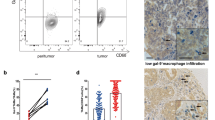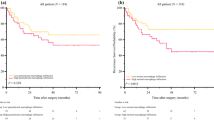Abstract
Background
Muscle-invasive bladder cancer (MIBC) is an aggressive and heterogeneous malignancy. Tumor-associated macrophages (TAMs) are key infiltrating cell populations in the inflammatory microenvironment of malignant tumors including MIBC. It intrigues us to explore the clinical significance and immunoregulatory role of TAMs infiltration and polarization in MIBC.
Methods
A total of 141 patients with MIBC from Zhongshan Hospital and 391 patients with MIBC from The Cancer Genome Atlas (TCGA) database were included in this study. Moreover, 195 patients who received anti-PD-L1 therapy from the IMvigor210 trial were enrolled. Patients were categorized into three subtypes considering the infiltration level and polarization status of TAMs, denoted as TAMlow (Subtype I), TAMhigh&M2/M1low (Subtype II), and TAMhigh&M2/M1high (Subtype III).
Results
Subtype III suffered inferior prognosis, and Subtype II could benefit more from adjuvant chemotherapy (ACT). Subtype III was featured with increased pro-tumor cells and immunosuppressive cytokines, while Subtype II possessed more immunogenic cells infiltration with activated and tumoricidal properties. Subtype II and Subtype III presented basal/squamous-like characterization and showed additional prognostic merit beyond molecular classification. Subtype I exhibited elevated level of FGFR3 signature, while Subtype II had EGFR signaling activation and immunotherapeutic indication. Additionally, Subtype II patients were indeed highly sensitive to PD-L1 blockade therapy in IMvigor210 trial.
Conclusion
The infiltration and polarization status of TAMs shaped distinct immune microenvironment with predictive significance for survival outcome, ACT benefit, and PD-L1 blockade therapy sensitivity in MIBC. Immune classification based on TAMs polarization and infiltration might provide tools to tailor chemotherapy and immunotherapy.




Similar content being viewed by others
Data availability
All data generated that are relevant to the results presented in this article are included in this article. Other data that were not relevant for the results presented here are available from the corresponding author Prof. Xu upon reasonable request.
Abbreviations
- ACT:
-
Adjuvant chemotherapy
- AJCC:
-
American Joint Committee on Cancer
- CI:
-
Confidence interval
- CR:
-
Complete response
- CTLA-4:
-
Cytotoxic T-lymphocyte-associated protein 4
- EGFR:
-
Epidermal growth factor receptor
- FPKM:
-
Fragments Per Kilobase of transcript per Million mapped reads
- FGFR3:
-
Fibroblast growth factor 3
- GZMB:
-
Granzyme B
- HLA-DR:
-
Human leukocyte antigen DR
- HPF:
-
High power field
- HR:
-
Hazard ratio
- IC:
-
Immune cells
- ICIs:
-
Immune checkpoint inhibitors
- IFN-γ:
-
Interferon γ
- IHC:
-
Immunohistochemistry
- IL-10:
-
Interleukin 10
- LAG-3:
-
Lymphocyte-activation gene 3
- MIBC:
-
Muscle-invasive bladder cancer
- NAC:
-
Neoadjuvant chemotherapy
- NE:
-
Not evaluated
- NMIBC:
-
Non-muscle-invasive bladder cancer
- OS:
-
Overall survival
- PD:
-
Progressive disease
- PD-1:
-
Programmed cell death protein 1
- PD-L1:
-
Programmed cell death ligand protein 1
- PR:
-
Partial response
- PRF-1:
-
Perforin 1
- RC:
-
Radical cystectomy
- RFS:
-
Recurrence-free survival
- SD:
-
Stable disease
- TAMs:
-
Tumor-associated macrophages
- TC:
-
Tumor cells
- TCGA:
-
The Cancer Genome Atlas
- TGF-β:
-
Transforming growth factor β
- TIGIT:
-
T-cell immunoreceptor with Ig and ITIM domains
- TIM-3:
-
T-cell immunoglobulin and mucin‐domain containing‐3
- TMA:
-
Tissue microarray analysis
- TMB:
-
Tumor mutation burden
- TME:
-
Tumor microenvironment
References
Sanli O, Dobruch J, Knowles MA, Burger M, Alemozaffar M, Nielsen ME et al (2017) Bladder cancer Nat Rev Dis Primers 3:17022
Johnson SB, Yu JB (2018) Bladder preserving trimodality therapy for muscle-invasive bladder cancer. Curr Oncol Rep 20:66
Chou R, Selph SS, Buckley DI, Gustafson KS, Griffin JC, Grusing SE et al (2016) Treatment of muscle-invasive bladder cancer: a systematic review. Cancer 122:842–851
Taylor J, Becher E, Steinberg GD (2020) Update on the guideline of guidelines: non-muscle-invasive bladder cancer. BJU Int 125:197–205
Schneider AK, Chevalier MF, Derre L (2019) The multifaceted immune regulation of bladder cancer. Nat Rev Urol 16:613–630
Witjes JA, Bruins HM, Cathomas R, Comperat EM, Cowan NC, Gakis G et al (2021) European association of urology guidelines on muscle-invasive and metastatic bladder cancer: Summary of the 2020 guidelines. Eur Urol 79:82–104
Cumberbatch MGK, Jubber I, Black PC, Esperto F, Figueroa JD, Kamat AM et al (2018) Epidemiology of bladder cancer: a systematic review and contemporary update of risk factors in 2018. Eur Urol 74:784–795
Patel VG, Oh WK, Galsky MD (2020) Treatment of muscle-invasive and advanced bladder cancer in 2020. CA Cancer J Clin 70:404–423
Ngambenjawong C, Gustafson HH, Pun SH (2017) Progress in tumor-associated macrophage (TAM)-targeted therapeutics. Adv Drug Deliv Rev 114:206–221
Najafi M, Hashemi Goradel N, Farhood B, Salehi E, Nashtaei MS, Khanlarkhani N et al (2019) Macrophage polarity in cancer: a review. J Cell Biochem 120:2756–2765
Li X, Liu R, Su X, Pan Y, Han X, Shao C et al (2019) Harnessing tumor-associated macrophages as aids for cancer immunotherapy. Mol Cancer 18:177
Cioni B, Zaalberg A, van Beijnum JR, Melis MHM, van Burgsteden J, Muraro MJ et al (2020) Androgen receptor signalling in macrophages promotes TREM-1-mediated prostate cancer cell line migration and invasion. Nat Commun 11:4498
Mantovani A, Sozzani S, Locati M, Allavena P, Sica A (2002) Macrophage polarization: tumor-associated macrophages as a paradigm for polarized M2 mononuclear phagocytes. Trends Immunol 23:549–555
Fu H, Zhu Y, Wang Y, Liu Z, Zhang J, Xie H et al (2018) Identification and validation of stromal immunotype predict survival and benefit from adjuvant chemotherapy in patients with muscle-invasive bladder cancer. Clin Cancer Res 24:3069–3078
Hu B, Wang Z, Zeng H, Qi Y, Chen Y, Wang T et al (2020) Blockade of DC-SIGN(+) tumor-associated macrophages reactivates antitumor immunity and improves immunotherapy in muscle-invasive bladder cancer. Cancer Res 80:1707–1719
Qi Y, Chang Y, Wang Z, Chen L, Kong Y, Zhang P et al (2019) Tumor-associated macrophages expressing galectin-9 identify immunoevasive subtype muscle-invasive bladder cancer with poor prognosis but favorable adjuvant chemotherapeutic response. Cancer Immunol Immunother 68:2067–2080
Zeng H, Zhou Q, Wang Z, Zhang H, Liu Z, Huang Q, et al (2020) Stromal LAG-3(+) cells infiltration defines poor prognosis subtype muscle-invasive bladder cancer with immunoevasive contexture. J Immunother Cancer. 8.
Mariathasan S, Turley SJ, Nickles D, Castiglioni A, Yuen K, Wang Y et al (2018) TGFbeta attenuates tumour response to PD-L1 blockade by contributing to exclusion of T cells. Nature 554:544–548
Taber A, Christensen E, Lamy P, Nordentoft I, Prip F, Lindskrog SV et al (2020) Molecular correlates of cisplatin-based chemotherapy response in muscle invasive bladder cancer by integrated multi-omics analysis. Nat Commun 11:4858
Zeng H, Liu Z, Wang Z, Zhou Q, Qi Y, Chen Y et al (2020) Intratumoral IL22-producing cells define immunoevasive subtype muscle-invasive bladder cancer with poor prognosis and superior nivolumab responses. Int J Cancer 146:542–552
Salmaninejad A, Valilou SF, Soltani A, Ahmadi S, Abarghan YJ, Rosengren RJ et al (2019) Tumor-associated macrophages: role in cancer development and therapeutic implications. Cell Oncol (Dordr) 42:591–608
Gunesch JT, Dixon AL, Ebrahim TA, Berrien-Elliott MM, Tatineni S, Kumar T, et al (2020) CD56 regulates human NK cell cytotoxicity through Pyk2. Elife. 9
Levine AG, Mendoza A, Hemmers S, Moltedo B, Niec RE, Schizas M et al (2017) Stability and function of regulatory T cells expressing the transcription factor T-bet. Nature 546:421–425
Stark JM, Tibbitt CA, Coquet JM (2019) The metabolic requirements of Th2 cell differentiation. Front Immunol 10:2318
Scapini P, Marini O, Tecchio C, Cassatella MA (2016) Human neutrophils in the saga of cellular heterogeneity: insights and open questions. Immunol Rev 273:48–60
Lenis AT, Lec PM, Chamie K, Mshs MD (2020) Bladder cancer: a review. JAMA 324:1980–1991
Kamoun A, de Reynies A, Allory Y, Sjodahl G, Robertson AG, Seiler R et al (2020) A consensus molecular classification of muscle-invasive bladder cancer. Eur Urol 77:420–433
Powles T, Huddart RA, Elliott T, Sarker SJ, Ackerman C, Jones R et al (2017) Phase III, double-blind, randomized trial that compared maintenance Lapatinib versus placebo after first-line chemotherapy in patients with human epidermal growth factor receptor 1/2-positive metastatic bladder cancer. J Clin Oncol 35:48–55
Loriot Y, Necchi A, Park SH, Garcia-Donas J, Huddart R, Burgess E et al (2019) Erdafitinib in locally advanced or metastatic urothelial carcinoma. N Engl J Med 381:338–348
Chen L, Han X (2015) Anti-PD-1/PD-L1 therapy of human cancer: past, present, and future. J Clin Invest 125:3384–3391
Pathria P, Louis TL, Varner JA (2019) Targeting tumor-associated macrophages in cancer. Trends Immunol 40:310–327
DeNardo DG, Ruffell B (2019) Macrophages as regulators of tumour immunity and immunotherapy. Nat Rev Immunol 19:369–382
Lobo N, Mount C, Omar K, Nair R, Thurairaja R, Khan MS (2017) Landmarks in the treatment of muscle-invasive bladder cancer. Nat Rev Urol 14:565–574
Tan TZ, Rouanne M, Tan KT, Huang RY, Thiery JP (2019) Molecular subtypes of urothelial bladder cancer: results from a meta-cohort analysis of 2411 tumors. Eur Urol 75:423–432
Choi W, Porten S, Kim S, Willis D, Plimack ER, Hoffman-Censits J et al (2014) Identification of distinct basal and luminal subtypes of muscle-invasive bladder cancer with different sensitivities to frontline chemotherapy. Cancer Cell 25:152–165
Zeng D, Ye Z, Wu J, Zhou R, Fan X, Wang G et al (2020) Macrophage correlates with immunophenotype and predicts anti-PD-L1 response of urothelial cancer. Theranostics 10:7002–7014
Robertson AG, Kim J, Al-Ahmadie H, Bellmunt J, Guo G, Cherniack AD et al (2017) Comprehensive molecular characterization of muscle-invasive bladder cancer. Cell. 171:540–56
Acknowledgements
We thank Dr. Lingli Chen (Department of Pathology, Zhongshan Hospital, Fudan University, Shanghai, China) and Dr. Yunyi Kong (Department of Pathology, Fudan University Shanghai Cancer Center, Shanghai, China) for their excellent pathological technology help.
Funding
This study was funded by grants from National Natural Science Foundation of China (31770851, 81872082, 82002670, 82103408), Shanghai Municipal Natural Science Foundation (19ZR1431800), Shanghai Sailing Program (18YF1404500, 21YF1407000), Shanghai Municipal Commission of Health and Family Planning Program (201840168) and Fudan University Shanghai Cancer Center for Outstanding Youth Scholars Foundation (YJYQ201802). All these study sponsors have no roles in the study design, in the collection, analysis, and interpretation of data.
Author information
Authors and Affiliations
Contributions
M. Sun, H. Zeng, K. Jin, and Z. Liu involved in acquisition of data, analysis and interpretation of data, statistical analysis, and drafting of the manuscript; C. Liu, S. Yan, Y. Yu, R. You, H. Zhang, Y. Chang, Y. Wang, L. Liu, and Y. Zhu involved in technical and material support; J. Xu, L. Xu, and Z. Wang involved in study concept and design, analysis and interpretation of data, drafting of the manuscript, and obtained funding and study supervision. All authors read and approved the final manuscript.
Corresponding authors
Ethics declarations
Conflict of interest
The authors declare that they have no competing interests.
Ethics approval
The study was approved by the Clinical Research Ethics Committee of Zhongshan Hospital, Fudan University, with the approval number Y2015-054. Written informed consent was obtained from each patient included and this study was performed under the Declaration of Helsinki. Signed informed consent was obtained from each patient.
Consent for publication
All authors provide their consent for publication.
Study approval
This study was approved by the Clinical Research Ethics Committee of Zhongshan Hospital, Fudan University (No. B2015-030). Written informed consent was obtained from each patient.
Additional information
Publisher's Note
Springer Nature remains neutral with regard to jurisdictional claims in published maps and institutional affiliations.
Supplementary Information
Below is the link to the electronic supplementary material.
Rights and permissions
About this article
Cite this article
Sun, M., Zeng, H., Jin, K. et al. Infiltration and Polarization of Tumor-associated Macrophages Predict Prognosis and Therapeutic Benefit in Muscle-Invasive Bladder Cancer. Cancer Immunol Immunother 71, 1497–1506 (2022). https://doi.org/10.1007/s00262-021-03098-w
Received:
Accepted:
Published:
Issue Date:
DOI: https://doi.org/10.1007/s00262-021-03098-w




